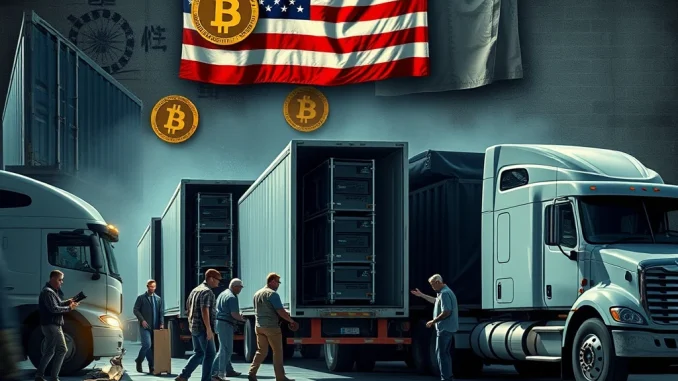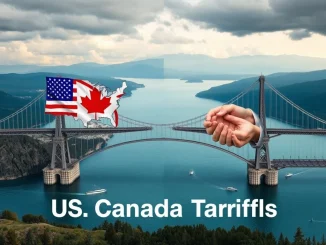
Are you ready for the next big shake-up in the crypto mining world? New tariffs imposed by the U.S. are sending ripples through the industry, and American crypto miners are bracing for impact. While the initial tariff rate of 10% might seem like a slight nudge, experts warn it’s enough to trigger significant changes in strategy and investment. Let’s dive into what this means for the future of US crypto mining and your crypto portfolio.
Why are US Crypto Miners Rushing to Buy Hardware?
The core reason behind this accelerated hardware buying spree is simple: anticipation of higher costs. Jaran Mellerud, the CEO of Hashlabs Mining, points out that these new tariffs, even at a lower-than-expected 10%, will erode the competitive edge of U.S. miners. It’s a classic case of businesses trying to get ahead of the curve. Think of it like this:
- Increased Capital Costs: Tariffs directly inflate the price of imported mining equipment. This means miners have to spend more upfront to acquire the same hardware.
- Long-Term Investment Concerns: Higher capital expenditure can dampen enthusiasm for new mining ventures and expansions within the U.S. The profitability calculus changes when equipment becomes more expensive.
- Short-Term Reactive Measures: To mitigate the immediate impact, miners are rushing to import mining rigs before tariffs potentially escalate further. This creates a temporary surge in demand.
Ethan Vera, COO of Luxor Technology, confirms this trend, noting that prices for mining equipment are already on the rise. This suggests the market is reacting swiftly to the tariff news, with both equipment suppliers and miners adjusting their strategies.
What are the Potential Benefits of Acting Now on Hardware Purchases?
For savvy crypto miners, this situation presents a window of opportunity. While tariffs are generally seen as a negative, acting preemptively can offer some advantages:
- Locking in Lower Prices: By purchasing mining rigs now, before prices potentially climb higher due to increased demand and future tariff hikes, miners can secure equipment at a relatively lower cost.
- Maintaining Competitive Edge: Miners who act quickly can maintain or even improve their operational capacity compared to those who delay and face higher equipment costs later.
- Strategic Inventory Building: This rush could also be about building a strategic reserve of hardware, anticipating future demand or potential supply chain disruptions.
However, it’s crucial to remember that this is a short-term reactive strategy. The long-term implications of these tariffs are still unfolding.
What Challenges Do US Crypto Miners Face with These New Tariffs?
While proactive hardware buying might offer temporary relief, US crypto miners are staring down some significant challenges due to these tariffs:
| Challenge | Description |
|---|---|
| Reduced Competitiveness | Higher capital costs make it harder for US miners to compete globally, especially against regions with lower energy costs and no tariffs. |
| Increased Operational Costs | While the tariff is on hardware, increased capital expenditure impacts overall operational budgets and profitability margins. |
| Uncertainty and Market Volatility | The fluctuating nature of tariffs and potential for further increases create uncertainty, making long-term planning difficult. |
| Potential for Retaliatory Tariffs | While not explicitly mentioned, trade tensions can escalate, potentially leading to retaliatory tariffs that could further impact the crypto industry. |
Examples of How Tariffs Can Impact Crypto Mining Businesses
Let’s illustrate the impact with a simplified example. Imagine a US crypto mining firm planning to expand its operations by purchasing 100 new mining rigs:
Scenario 1: No Tariffs
- Cost per mining rig: $10,000
- Total hardware cost: $1,000,000
Scenario 2: 10% Tariff
- Cost per mining rig (including tariff): $10,000 + (10% of $10,000) = $11,000
- Total hardware cost: $1,100,000
- Additional cost due to tariff: $100,000
This $100,000 increase directly impacts the miner’s capital expenditure, potentially affecting profitability, expansion plans, and even the ability to secure financing. For larger operations purchasing thousands of rigs, these costs can quickly become substantial.
Actionable Insights for Crypto Miners and Investors
So, what should crypto miners and investors take away from this situation?
For Crypto Miners:
- Assess Your Hardware Needs: Evaluate your short-term and long-term hardware requirements. Is it beneficial to accelerate purchases now?
- Factor Tariffs into Financial Models: Update your financial projections to account for increased hardware costs due to tariffs.
- Explore Domestic Sourcing: Investigate opportunities for sourcing mining equipment domestically to mitigate tariff impacts, although this might currently be limited.
- Monitor Regulatory Developments: Stay informed about any changes in tariff policies and potential government support for the crypto mining industry.
For Crypto Investors:
- Understand Miner Profitability: Recognize that tariffs can impact the profitability of US crypto mining operations, which can indirectly affect the broader crypto ecosystem.
- Evaluate Mining Company Strategies: Pay attention to how publicly traded mining companies are adapting to these tariff challenges. Are they diversifying geographically? Are they innovating to improve efficiency?
- Consider Geopolitical Factors: Be aware that geopolitical events and trade policies can significantly influence the crypto market, especially sectors like mining that rely on international supply chains.
Conclusion: Navigating the Tariff Terrain in Crypto Mining
The introduction of tariffs on mining rigs is a critical development for the US crypto mining industry. While the immediate response is a surge in hardware purchases, the long-term consequences require careful consideration. For crypto miners, strategic planning, adaptability, and a keen understanding of the evolving regulatory landscape will be essential to navigate this new terrain. For investors, understanding these challenges provides valuable insights into the resilience and adaptability of the crypto mining sector. The race to adapt is on, and the coming months will reveal how effectively US crypto miners can weather this tariff storm and maintain their position in the global crypto arena.



